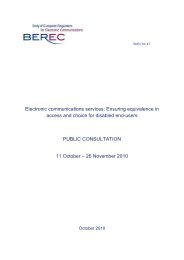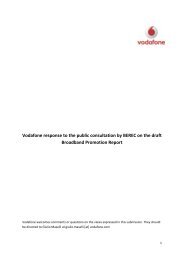BEREC REPORT ON IMPACT OF FIXED-MOBILE ... - berec - Europa
BEREC REPORT ON IMPACT OF FIXED-MOBILE ... - berec - Europa
BEREC REPORT ON IMPACT OF FIXED-MOBILE ... - berec - Europa
You also want an ePaper? Increase the reach of your titles
YUMPU automatically turns print PDFs into web optimized ePapers that Google loves.
BoR (11) 54<br />
was no two-way substitution between these services. If there was a SSNIP of retail<br />
fixed access services, fixed subscribers would switch to mobile telephony<br />
subscriptions. But, if there was a SSNIP of retail mobile access services, mobile<br />
subscribers would not switch to fixed telephony subscriptions. In this case FICORA<br />
considered that the non symmetric substitution lead to the definition of two separate<br />
markets: retail mobile access is a distinct adjacent product market which gives<br />
rise to competitive constraints being exercised on operators in the fixed access<br />
market”.<br />
Afterwards FICORA verified that the fixed access market did not meet three cumulative<br />
criteria for ex ante regulation. In consequence FICORA proposed to withdraw the<br />
existing SMP designations in the related fixed markets.<br />
In general, the information relevant to an asymmetric substitution analysis is the same<br />
as in a symmetric substitution analysis. However, in the asymmetric substitution cases<br />
it may be more important for NRAs to collect information that can explain the reason<br />
behind the existence of asymmetric substitution (why end users change from A to B<br />
and don’t change from B to A?).For instance, while considering asymmetric substitution<br />
between fixed and mobile services it can be relevant to analyses in detail if mobile<br />
users value the mobility feature such that they would be unwilling to switch to fixed<br />
services.<br />
4. EXISTENCE <strong>OF</strong> FMS<br />
To get a first overview of possible FMS trends in Europe, a preliminary quantitative<br />
analysis was carried out based on available data. Data published by the European<br />
Commission through the Implementation reports, the Digital Agenda Scoreboard 14,15<br />
and the E-communication Household Survey 16 provides indicators that are relevant for<br />
a preliminary analysis of FMS.<br />
However, the level of FMS and its impact on market analysis requires a deep<br />
understanding of local characteristics in each country. Trends that may be extracted<br />
from generic information should thus be handled carefully and essentially regarded as<br />
illustrative only. A case by case analysis, carried out for each dedicated national<br />
market, is necessary to assess precisely the level of FMS.<br />
14<br />
http://ec.europa.eu/information_society/digital-agenda/scoreboard/index_en.htm<br />
15<br />
http://ec.europa.eu/information_society/digital-agenda/scoreboard/docs/pillar/electronic_communications.pdf<br />
16<br />
http://ec.europa.eu/information_society/digitalagenda/scoreboard/docs/pillar/studies/eb_ecomm/final_reports/reporteb751sp362infsoecommunications_en_final.pdf<br />
15





